If you’ve had Vietnamese food, you’ve probably at some point caught a whiff of these pungent Vietnamese pickled carrots and daikon. These are what you find inside Vietnamese bánh mì but also served on the side for various other recipes too.
Sometimes you’ll see it extremely heavy on the carrots with almost no daikon, but I like it with the reverse ratio. You can do what you like best, but I’ll show you how easy and quick it is to make this recipe!
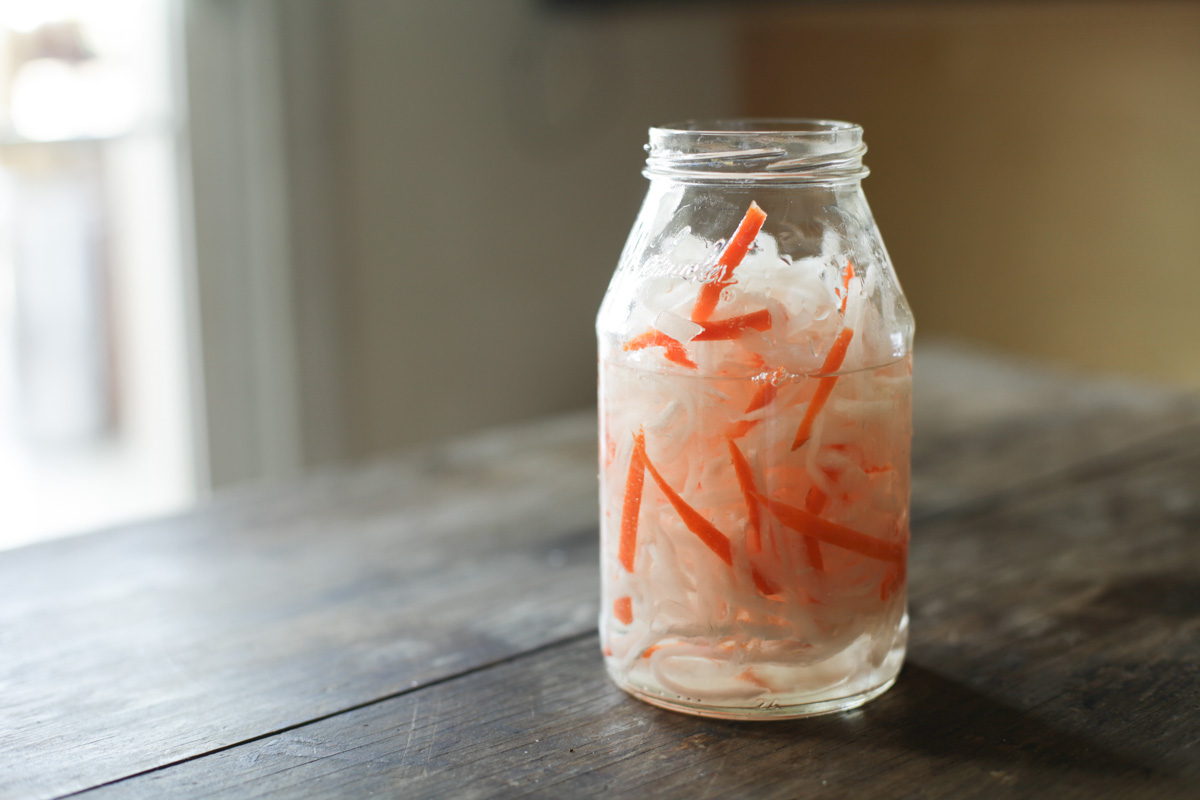
Đồ chua literally means “pickled stuff.” Weird right? It makes no sense to me to have such a generalized name because the vegetables in it don’t change–it’s always carrots and daikon.
But anyways, like pickles in other cuisine, they go well with salty or fatty foods. It’s great on Vietnamese sandwiches (bánh mì), savory crepes (bánh xèo), grilled pork and noodles (bún thịt nướng), egg rolls (chả gìo), and the list goes on. Larger cuts are usually found next to cuts of meat, while finer shreds are put in nước chấm (dipping sauce).
Daikon vs. carrot ratios
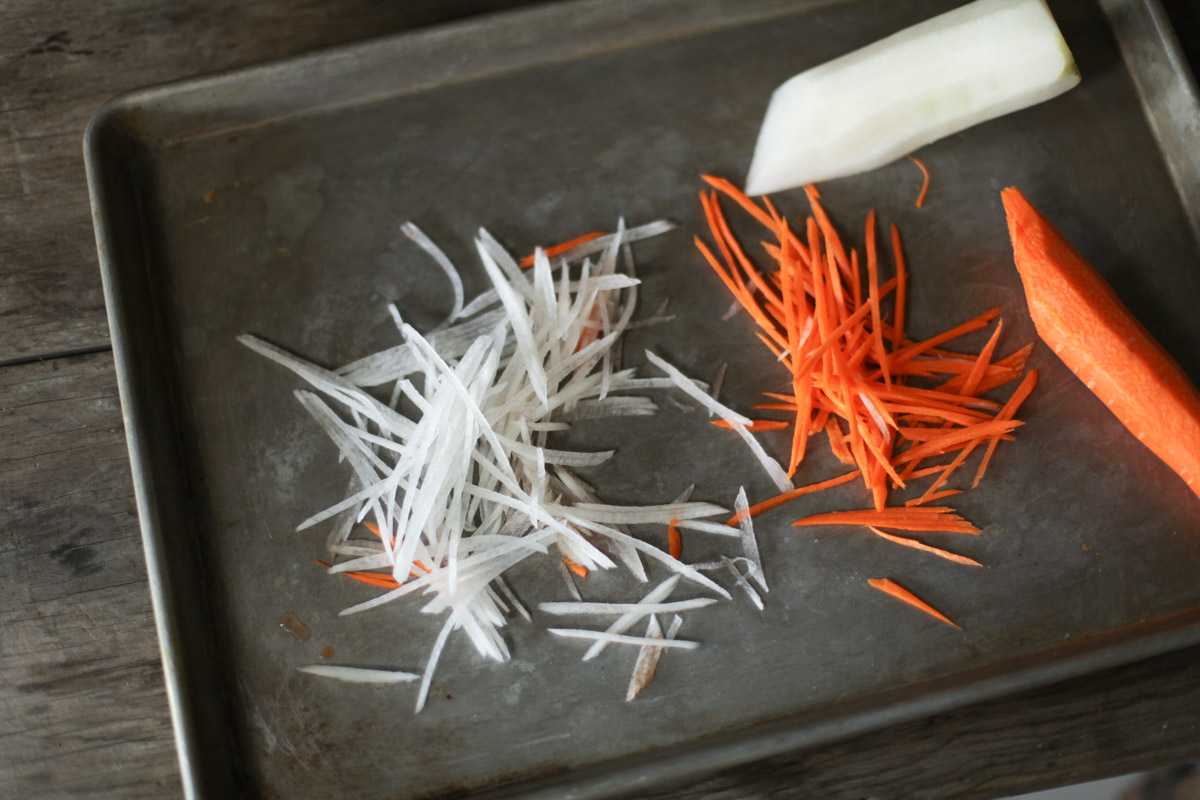
I learned that in Vietnam, đồ chua is mostly daikon simply because it is cheaper and carrots were added mainly for color. Here in the US the costs of these veggies are flipped so cost-conscious restaurants and shops will load up on the cheaper carrots.
In fact, when my parents first emigrated to the US, most restaurants in California didn’t use daikon at all. Some people like it better this way, and some have only ever seen it this way because of the specific bánh mì shops they visit.
Today, most restaurants I visit use a 50/50 mix of daikon and carrots. It’s what I grew up with and in this recipe, we’ll stick with that for familiarity. Before we get started, here’s a few notes on how to make đồ chua.
Customizing this pickle recipe
This recipe was originally customized by my Mom to be slightly less pungent and less sweet compared to the recipe you will find at most Vietnamese shops. This less vinegary formula is simply a matter of preference, and it will make your đồ chua last longer in the fridge before it expires.
Following this recipe also creates đồ chua that’s ready to be added to nước chấm to taste–you won’t need to wring out or rinse the pickles beforehand.
If you’re in a rush and want to eat these within a few hours and don’t care to save extras for another day, adjust the solution for an even higher vinegar to water ratio.
Preparation tips
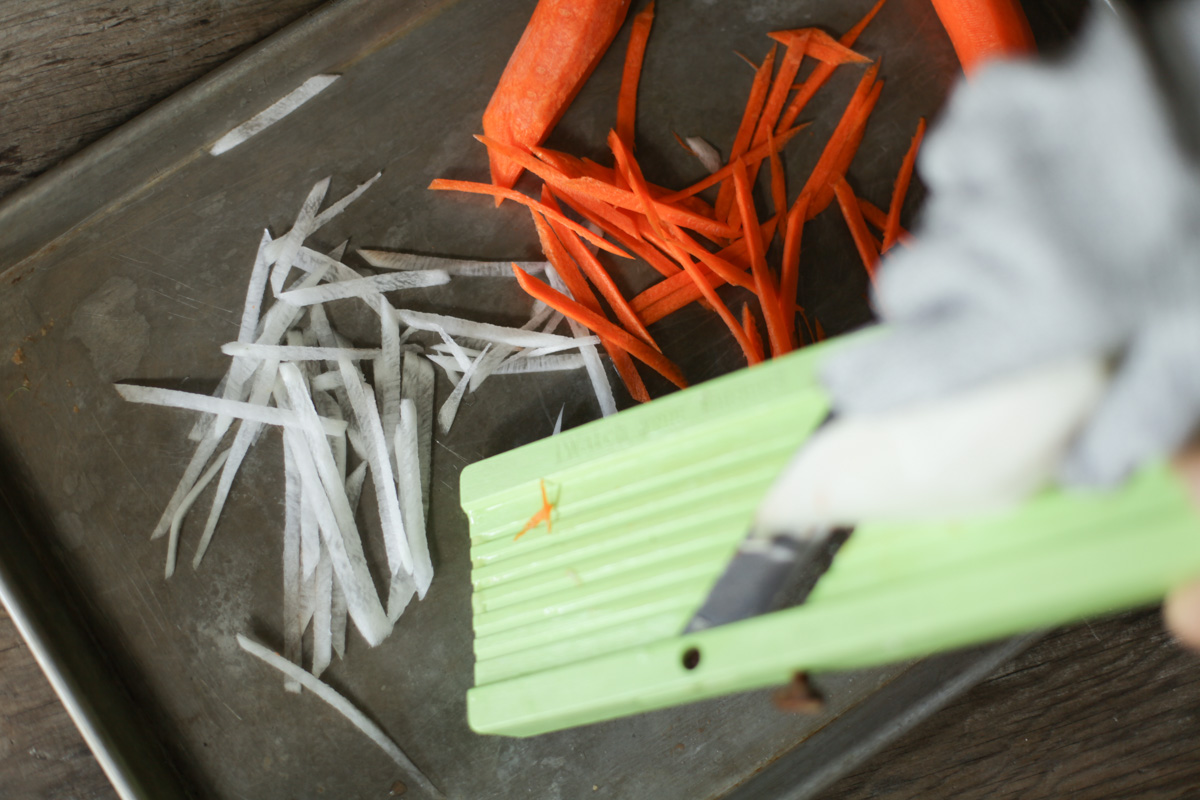
So peel and then shred your veggies to the size you want. Smaller matchstick cuts will get more sour than larger ones. Use a mandolin slicer for more uniform cuts. A good mandolin like the one I linked is extremely sharp. You can also use a super sharp boxed grater too.
My aunt admitted she gave up and donated her mandolin cutter after trying it out, but she did it bare-handed. I have since heard many other counts from people I know, to TV chefs having this same fate.
Yes this mandolins can be super dangerous, but so are kitchen knives and cholesterol intake if you don’t handle them properly. I always use a (magical) cut-resistant glove so you can cut all the veggies down to the little bits and reduce waste.
If you’re still concerned about cutting the little bits on the mandolin, simply only use it down to a size you’re comfortable with, then finish cutting the small bits with a normal chefs knife.
Salting for moisture removal
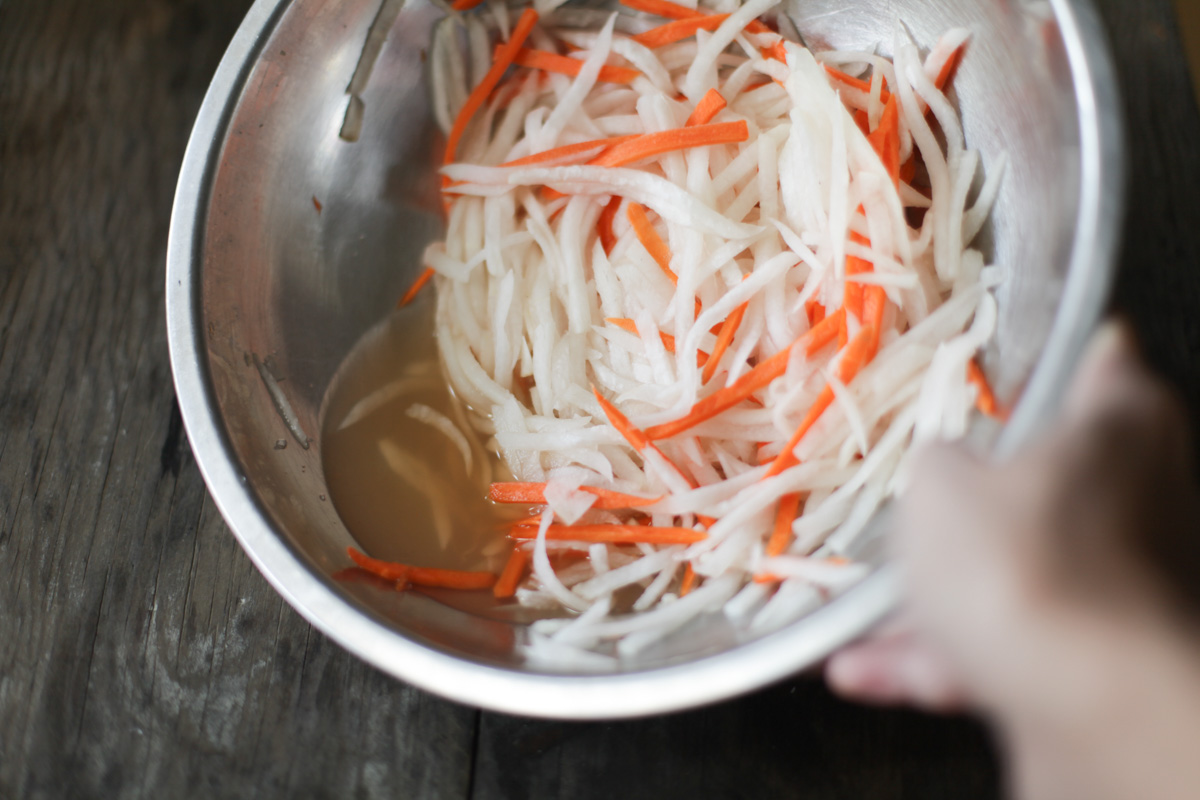
Next, we want to sprinkle salt on the daikon and carrots and mix it thoroughly. This removes some of the odor, and color. If you let it sit longer than 15 minutes, more salt will be absorbed. This is the same process we do for Japanese cucumber salad and Chinese cucumber salad!
Note how the carrots and daikon lose their rigid shape, get a little softer and wobblier after the salt gets to work on them. They release water too. Rinse thoroughly and lightly squeeze in batches to remove excess moisture. If you grab smaller amounts in your hand at a time, it will take a bit longer but it will be easier to remove more moisture with each squeeze.
Transfer into jars. You don’t need to leave a ton of headroom at the top, so just feel free to load it up or split amongst smaller jars to gift to family and friends.
Then, top off with the vinegar solution so that it covers all the veggies. If you’re a bit short on liquid, you can simply add filtered water to top off the jars.
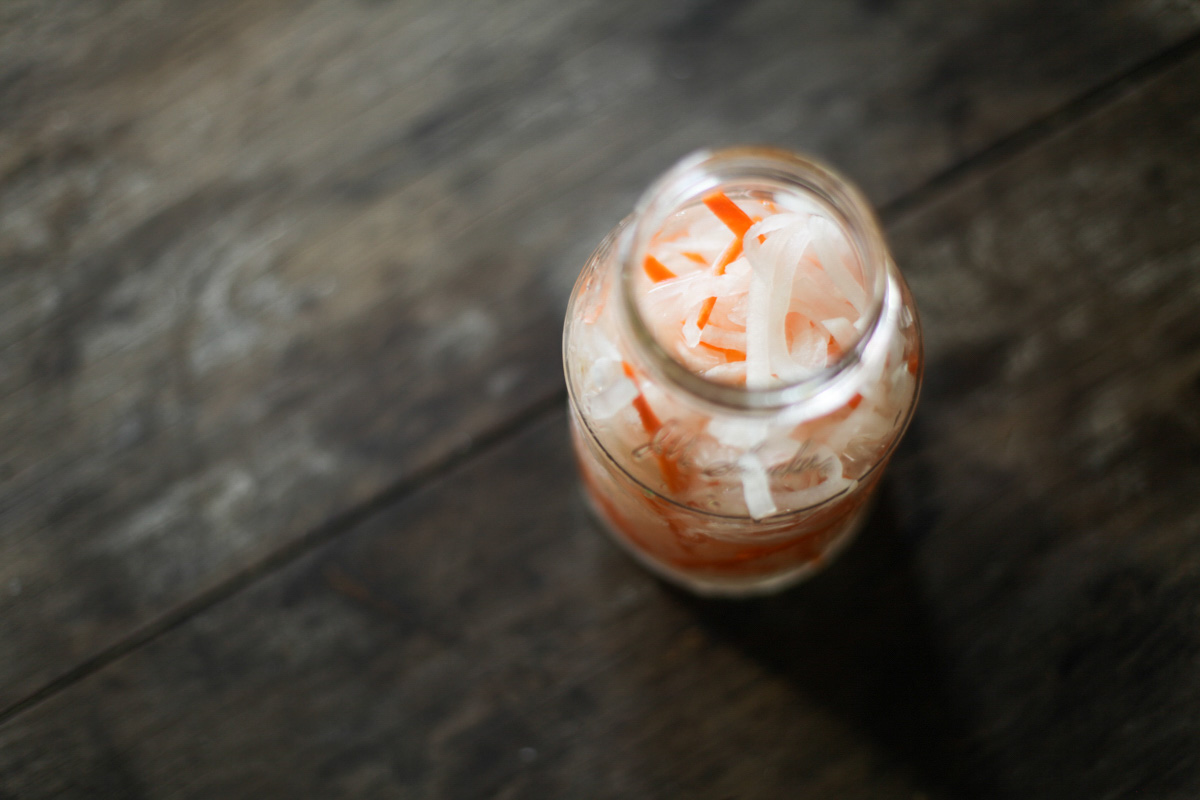
Depending on the weather or where you store these jars, it should take about 2-3 days until its sour enough and ready to eat. Taste a piece every 12 or 24 hours to check on the progression of pickling.
When it’s really warm outside it can finish days sooner. If it’s really cold outside it may take a very long time–you can speed things up by turning on the light bulb in your oven and setting the jars near them. Just rotate the jars so each get a simliar amount of exposure.
What do you eat with Đồ Chua?
Literally everything. Đồ chua is great on Vietnamese sandwiches (bánh mì), savory crepes (bánh xèo), grilled pork and noodles (bún thịt nướng), egg rolls (chả gìo), and the list goes on. Larger cuts are usually found next to cuts of meat, while finer shreds are put in nước chấm (dipping sauce).
How long do pickled carrots last?
Pickled carrots can last up to five months in the refrigerator, but as long as they haven’t become too sour its ok to eat.
Are pickled vegetables good for you?
Pickled vegetables, like đồ chua, have a lot of healthy benefits due to the fermentation brine that creates good bacteria for your gut and overall body. For a quick pickle recipe, you can also make Korean pickled daikon radish too.
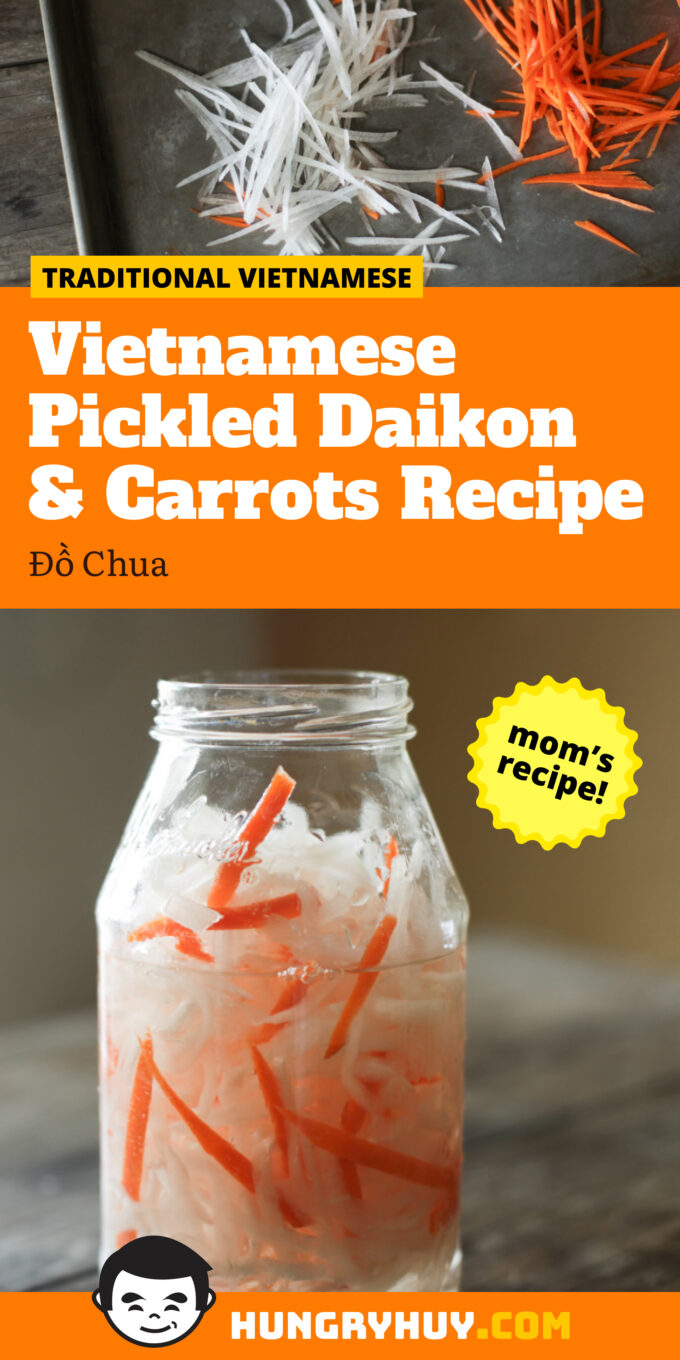
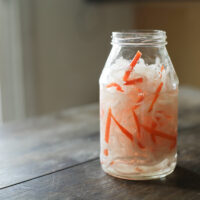
Vietnamese Daikon & Carrot Pickles Recipe (Đồ Chua)
Ingredients
- 1/2 lb (226.8 g) daikon radish
- 1/2 lb (226.8 g) carrots
- 1 tbsp salt
Vinegar Solution
- 1/2 c boiling water
- 5 tbsp granulated white sugar
- filtered room temp. water
- 4 tbsp distilled vinegar
Instructions
- Peel daikon and carrots, then cut with mandolin slicer medium to small matchsticks. Smaller cuts will pickle faster.
- In a large bowl, sprinkle with salt evenly and toss to coat. Soak for 15 minutes.
- Rinse thoroughly to remove the salt and in small handfulls, squeeze to remove as much moister as you can.
- Add to jars, filling almost to the top.
Vinegar Solution
- Boil water then add sugar, mix to dissolve, then add vinegar.
- Pour this liquid evenly into your jars. If needed, add extra room temp water to barely fully submerge the veggies.
- Screw on the lids, store at room temperature until pickled to your taste, checking every 12 or 24 hours. It usually takes 2-5 days depending on the temperature.
- Refrigerate when ready, for up to 3 weeks, or until too sour or veggies lose their crunch.



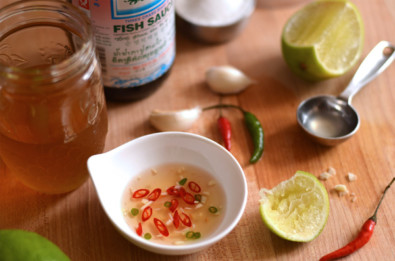






Definetely love it in Banh Mi! 🙂
Yesss, sometimes people put too much in it for my taste. I like the pickles milder. Less stick, more crunch.
Do you recommend a mild rice vinegar, or something stronger like white or cider vinegar?
Hey Shannon! I honestly haven’t experimented with other vinegars to answer that. I use distilled white.
This is great! I got turned onto Vietnamese food by my friend in high school. His mother didn’t speak much English and she thought all us white boys looked alike, but she was nice and cooked some awesome food. We love Vietnamese food in our family and now ever Sunday night is bun thit nuong night. Thanks for the tasty recipes!
Hey Nick, glad to hear you enjoy Vietnamese cuisine enough to have it every week!
Thanks for the easy to follow instruction. My family love it.
Hey Jason, I’m glad you and your family enjoyed the recipe. I’m due to make another batch :). Thanks for stopping by!
I do love pickled veggies from all walks of life. The first time I pickled veggies was with my mother and we just made country style pickles! I LOVE picked carrots and cauliflower but this recipes looks absolutely delicious! Thanks for sharing!
I’m with you on that Richard. Pickles are delicious! Cauliflower immediately brings to mind the ones you find at Mexican salsa bars. Thanks for stopping by!
Hi Huy, I just want to say that it has been years since I saw that veggie peeler : )
Hey thanks for leaving a comment May. Yep thats my little cheapo peeler. There are definitely better tools available, but likely few with that ‘Vietnamese’ vibe 🙂
HI Huy! Glad I found this site. My questions: I didn’t see where you said what size the pickle jars should be and how many you need to make this? Also, a lot of recipes I have seen have the sugar and salt mixed with the veggies to leach out the water. Does just using the salt get rid of the “stinkiness”? Thanks! 🙂
Huy, hi! I thought I sent a question about the diakon and carrot pickle but don’t see it here. Your picture shows 3 ball jars. Is that how many are needed to fit this entire recipe? Or do I need more than that?
Sorry for all the questions. I see recipes where people add fish sauce. Is that also authentic? I haven’t added stars because I haven’t made the recipe yet. I need to know how many jars I need before I start.
Yeah for this amount (1lb total) 3 or 4 jars should do the trick. Fish sauce is added just before you eat only, not to prepare the pickles. Let me know how this works out for you Kirsten!
Would I be able to get away with making with a grater for (non-vietnamese) people? ie I love it but could not do that with a knife.
I made your pickled carrots and daikon yesterday morning. They are the perfect level of acid and sweet! We put them on Banh Mi last night with home-made paté, cucumber, parilla leaves, mint leaves, and mung bean sprouts, on french baguette. I don’t know if that’s authentic but it was super delicious!
Heck yea glad you liked it Sarah! Thanks for trying it out, and sharing with us 🙂
Easy and delicious, and brought back lots of wonderful memories from Vietnam!
Wow thanks for sharing Rochelle 🙂
I’ve made this recipe several times with carrots, daikon, and even red onion. It couldn’t be easier and tastes great in salads and pitas and on sandwiches.
Glad to hear and thanks for the suggestion Elizabeth!
Just a heads up that the sugar amount is hard coded into the recipe and won’t be adjusted if you change the amount you are making. I made a third of a batch as a test and used only 5 teaspoons of sugar – one third the amount written in my printout.
Ahh sorry about that! I just updated the recipe so it should be working properly now.
Do you need to cool the brine liquid before pouring into the jars?
Hey hamtaro, cool it so its not boiling, but doesn’t need to be room temp before adding! I’ll update the recipe to clarify!
Hi Huy! Do you think I could use white turnip instead of daikon in a pinch? Thanks for this!
And/or what about jicama? Thank you!
I haven’t tested it but would say some pickle is better than none! If the veg/root you’re using is super dense, you may want to cut it finer so it pickles faster and is easier to eat.
Hey Huy! In a pinch, what are your thoughts on subbing daikon with white turnip, jicama or red radish? Thank you!
First thoughts are red radish can be really bitter, so I’d shred it really fine, and probably use less of it. Worth experimenting though!
Awesome – sorry for the double post and thank you for these responses!! Very helpful re slicing thinner for denser items. I’ll probably use white turnip and potentially some jicama since we’re thinking red radish may be a bit much. Much appreciated!!
The ratio of sugar to vinegar is perfect! We couldn’t wait we ate it all right away with our crepes. Yum!
Thank you for the great recipe!
You list water twice. 1/2 boiling water and 1 cup of water.
Which is it?
Hi Matthew, I updated the recipe to clarify. We need both–the boiling water is a smaller amount just so it boils and dissolves the sugar faster.
I’ve tried many recipes and this one is my favourite! I keep coming back to it over and over again. Thank you for posting. For more ‘restaurant style’ vibes, I add more sugar, lol, but it’s totally not necessary. TY from SF!
I love your recipes! I find that concentrated vinegar sometimes helps get that really tangy taste if it feels like regular distilled vinegar isn’t sour enough, no matter how much you add. I’ve made this twice! I